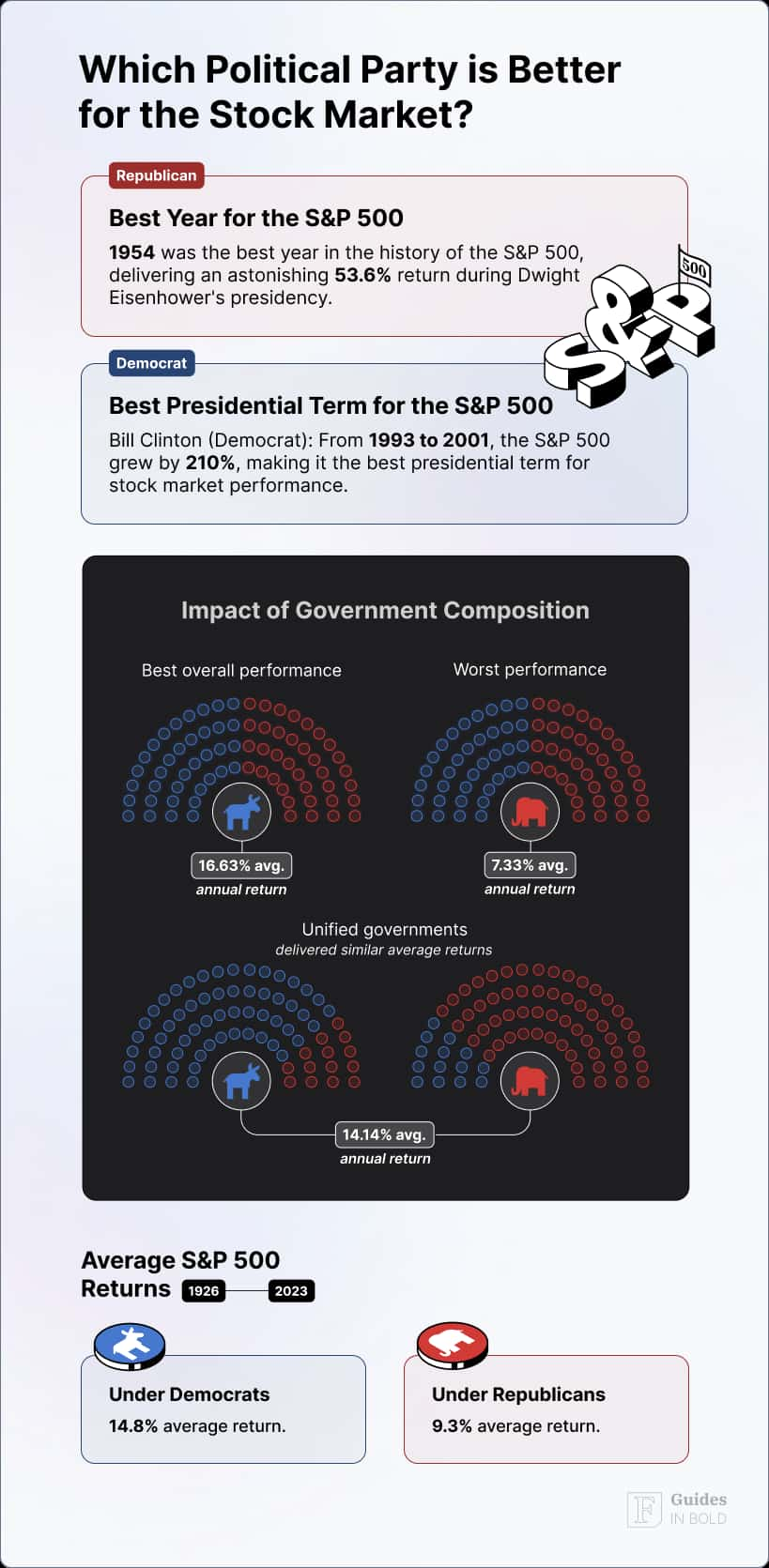The outcome of the presidential elections in the United States has a massive impact on national and global affairs, including the economy and the performance of the stock market. The investing public remains especially observant since many believe that investing prospects directly depend on the results. This article will analyze which political party is better for the stock market based on the available research and historical data.
4-year presidential cycle stock market: historical data
While predicting which political party would be better for the stock market after the November elections is difficult, reviewing the historical data is pretty straightforward, at least when it comes to the 4-year presidential cycle stock market effect.
Here’s a comprehensive table of the S&P 500 growth rate, measured in compound annual growth rate (CAGR), during American presidencies, according to Nasdaq:
| Republicans | Democrats | Term | S&P 500 CAGR |
| Dwight Eisenhower | 1957-1961 | 8.3% | |
| John Kennedy | 1961-1963 | 5.4% | |
| Lyndon Johnson | 1963-1969 | 7.6% | |
| Richard Nixon | 1969-1974 | -5.3% | |
| Gerald Ford | 1974-1977 | 10.4% | |
| Jimmy Carter | 1977-1981 | 6.3% | |
| Ronald Reagan | 1981-1989 | 10.2% | |
| George Bush | 1989-1993 | 10.8% | |
| Bill Clinton | 1993-2001 | 15.2% | |
| George W. Bush | 2001-2009 | -6.2% | |
| Barrack Obama | 2009-2017 | 13.8% | |
| Donald Trump | 2017-2021 | 14.1% | |
| Joe Biden | 2021-2024 | 11.0% | |
| Average S&P 500 CAGR – Republican | 6% | ||
| Average S&P 500 CAGR – Democrat | 9.9% | ||
| Median S&P 500 CAGR – Republican | 10.2% | ||
| Median S&P 500 CAGR – Democrat | 9.3% | ||
While the numbers are precise, the answer to the question of which political party was better for the stock market historically is not. It depends on how you do your calculations.

S&P 500 performance by president
The story is similar if we look back to 1926. Between 1926 and 2023, Republicans presided for 47 years, while Democratic presidents held the seat for 51 years.
According to research by WT Wealth Management, for the period, the average return for the S&P 500 index was 9.3% under Republicans and 14.8% under Democrats.
Unified and divided governments
The same research points to another, less discussed factor: the president of the U.S. can head a unified (both Congress and presidency held by the same party) or divided government, which also affects the stock market’s performance. Here’s the data for 1926-2023:
| Government | Duration | S&P 500 avg. annual return |
| Republican president, unified Congress | 13 years | 14.52% |
| Republican president, divided Congress | 34 years | 7.33% |
| Democratic president, unified Congress | 36 years | 14.01% |
| Democratic president, divided Congress | 15 years | 16.63% |
| Unified government (either party) | 49 years | 14.14% |
| Divided government (either party) | 49 years | 10.18% |
Once you do the math based on the government composition, you come to an interesting conclusion. The first noticeable thing is that the market’s historical performance has been pretty much the same for unified governments, whether it was under Republican or Democratic control. However, the results are surprising when one of the two Congress chambers is controlled by the rival party.
What was the best year ever for the S&P 500?
Historical data shows that a Democratic president is, on average, better for the stock market. So, the best year for the S&P 500 index must have been under a Democrat, right? Wrong.
What was the worst year ever for the S&P 500?
The worst year for the stock market was, conversely, 1931, during the presidency of Herbert Hoover, a Republican. Although there was no S&P index in 1931, we can use the DJIA to track the stock market’s performance in the period.
The DJIA lost almost 89% of its value from the 1929 peak, just before the stock market crash and the ensuing Great Depression. The crash of October 1929 caused the catastrophic decline of the stock market, which led to a banking crisis, high unemployment, and widespread poverty.
The best presidential term for the S&P 500
Past performance never cedes to surprise here, so the best presidential term for the stock market was under a Democrat: Bill Clinton. Between 1993 and 2001, the S&P 500 was up 210%.
The close second? Another Democrat: Barack Obama. During his tenure of two terms, from 2009 to 2017, the market was up 189%.
The third and fourth places go to Republican presidents Dwight Eisenhower and Ronald Reagan, respectively. Eisenhower’s term (1953-1961) saw the S&P rise 129%, while Reagan presided over a 117% rise between 1981 and 1989. The fifth place is, once again, Democratic, with Harry Truman witnessing an 87% rise between 1945 and 1953.
Here’s the data conveniently listed here:
| President | Tenure | S&P growth rate |
| Bill Clinton (D) | 1993-2001 | 210% |
| Barack Obama (D) | 2009-2017 | 189% |
| Dwight Eisenhower (R) | 1953-1961 | 129% |
| Ronald Reagan (R) | 1981-1989 | 117% |
| Harry Truman (D) | 1945-1953 | 87% |
How much influence does the president have on the stock market?
However, it is crucial not to rush to a conclusion that the president alone is responsible for stellar growth or an abysmal drop in the stock market. For example, Obama assumed the presidency at the tail end of the Great Recession and benefitted from the stock recovery. Although his government worked towards the bounce-back, the degree of effort versus circumstances can be debated.
Conversely, Trump’s presidency witnessed the global pandemic of COVID-19, the worst in more than a hundred years. The economy slowed as people were forced into quarantine, and the stock market plunged. Again, how his actual handling of the pandemic contributed to this trend is open for discussion.
To sum up, stock market movements rely on market trends much more than on the ruling political party. They can last for decades and usually have sources that run much deeper than the government’s mere fiscal policy. Donald Trump’s victory over Kamala Harris can hardly do much to fundamentally divert the stock market’s course, just as it would have been in the alternative scenario.
The bottom line
Finally, which political party is better for the stock market? The short and simplified answer is, on average, the Democratic party. Depending on the way you process historical performance, Republicans may come on top in some cases, but in the majority of cases, Democratic presidents had better stock market performance.
The long and complex answer is that, well, presidents and their governments have far less influence on the stock market than you would think. In fact, one could argue that the Democrats benefitted from more favorable timing, with fewer recessions and more growth periods under their leadership.
Ultimately, the stock market depends much more on current trends and climate than the governing political party. Rather than looking at presidential candidates, investors should check company fundamentals, follow a sound investing strategy, and always rely on their research when making decisions.
Disclaimer: The content on this site should not be considered investment advice. Investing is speculative. When investing, your capital is at risk.
FAQs about which political party is better for the stock market
Which political party is better for the stock market?
On average, the Democrats presided over periods of increased stock market growth when compared to their Republican rivals.
How does the president affect the economy?
The president can indirectly influence the economy through the fiscal and monetary policy of the government. That said, the person at the helm of the United States has a much less direct impact on the course of the economy than people think.
How does the president affect the economy?
The worst years for the stock market were those in the two great economic downturns, the Great Depression and the Great Recession.
Is a fully Democratic government the best for the stock market?
No, it is not, at least according to historical data. On average, the best government for the stock market is under a Democratic president and a divided Congress.
Which president had the best economy?
The best presidential term for the stock market was under Bill Clinton, who witnessed a 210% growth in the S&P 500 between 1993 and 2001.
Which president had the worst economy?
It is a political consensus that Herbert Hoover presided over the worst period for the U.S. economy. The underlying causes of the economic decline were the stock market crash of 1929 and the ensuing Great Depression.
Which year was the best for the stock market?
The best year for the stock market was 1954, under the presidency of Dwight Eisenhower, a Republican. That year, the S&P 500 returned an astonishing 53.6%.




